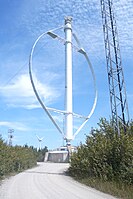
Photo from wikipedia
Abstract Small-scale or scaled-down wind turbines for model experiments mostly operate in low-Reynolds-number flow. The nonlinear variations of aerodynamic coefficients with respect to the angle of attack caused by viscous… Click to show full abstract
Abstract Small-scale or scaled-down wind turbines for model experiments mostly operate in low-Reynolds-number flow. The nonlinear variations of aerodynamic coefficients with respect to the angle of attack caused by viscous effects and laminar boundary layer separation affect the wind turbine performance under these conditions. Although the vortex lattice method (VLM) is an efficient way to predict rotor performance, it tends to suffer from numerical error because nonlinear aerodynamic characteristics cannot be considered. In this study, the nonlinear vortex lattice method (NVLM) is adopted to compute the aerodynamic loads of two small-scale wind turbines. This method involves a sectional airfoil look-up table and vortex strength correction and can be applied to a wide range of operating conditions. The simulations of TU Delft and NTNU wind turbines are conducted to validate the prediction capability of numerical models by comparing predictions with the measurements. It was found that the overall results from the NVLM simulation are more accurate than the VLM results, which implies that the nonlinear aerodynamic characteristics associated with low-Reynolds-number flow should be considered to accurately assess the aerodynamic performance of small-sized wind-turbines, particularly at the low tip speed ratio at which the rotor blade may experience flow separation and dynamic stall.
Journal Title: Renewable Energy
Year Published: 2020
Link to full text (if available)
Share on Social Media: Sign Up to like & get
recommendations!